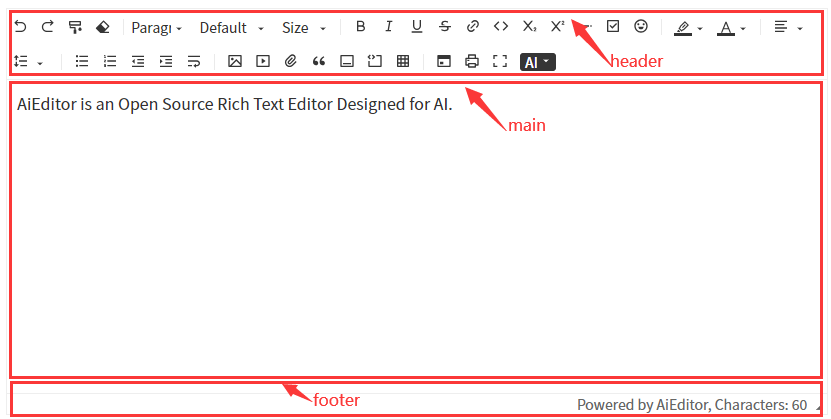Custom layouts
By default, when AiEditor is initialized, it will create the editor's head menu, editing area, and bottom word count display area. As shown in the figure below:

Default sample
以上截图的初始化代码如下:
<!doctype html>
<html lang="en">
<head>
<title>AiEditor Demo</title>
<meta charset="UTF-8"/>
<meta name="viewport" content="width=device-width, initial-scale=1.0"/>
<link type="text/css" rel="stylesheet" href="aieditor/style.css">
<script type="module">
import {AiEditor} from 'aieditor/index.js'
new AiEditor({
element: "#aiEditor",
placeholder: "Click to Input Content...",
content: 'AiEditor is an Open Source Rich Text Editor Designed for AI.',
})
</script>
</head>
<body>
<div id="aiEditor" style="height: 550px; margin: 20px"></div>
</body>
</html>Custom layouts
In some scenarios, we may want to customize the entire UI layout, such as adopting a Tencent Docs-style layout (demo link: http://doc.aieditor.com.cn), or other customized layout forms. We can achieve this using AiEditor's customizable UI features.
The sample code is as follows:
<!doctype html>
<html lang="en">
<head>
<title>AiEditor Demo</title>
<meta charset="UTF-8"/>
<meta name="viewport" content="width=device-width, initial-scale=1.0"/>
<link type="text/css" rel="stylesheet" href="aieditor/style.css">
<script type="module">
import {AiEditor} from 'aieditor/index.js'
new AiEditor({
element: "#aiEditor",
placeholder: "Click to Input Content...",
content: 'AiEditor is an Open Source Rich Text Editor Designed for AI.',
})
</script>
</head>
<body>
<div id="aiEditor" style="height: 550px; margin: 20px">
<div class="aie-container">
<div class="aie-container-header"></div>
<div class="aie-container-main"></div>
<div class="aie-container-footer"></div>
</div>
</div>
</body>
</html>In the provided code, an additional <div> with the class name aie-container and its three child <div> elements have been added compared to the default code. The purpose of these child <div> elements is as follows:
aie-container-header: Used to fill the header menu content.aie-container-main: Used to fill the middle editing area.aie-container-footer: Used to fill the footer content.
The order, position, structure, and nesting depth of these three child <div> elements can be changed in any way to achieve the desired layout. However, they must all be wrapped within a <div> with the class name aie-container. This allows us to implement any layout we want.
